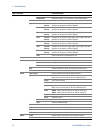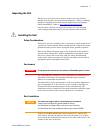
Installation 2
Series N6700 User’s Guide 21
Inspecting the Unit
When you receive your power system, inspect it for any obvious
damage that may have occurred during shipment. If there is damage,
notify the shipping carrier and nearest Agilent Sales and Support
Office immediately. Refer to www.agilent.com/find/assist
.
Until you have checked out the power system, save the shipping
carton and packing materials in case the unit has to be returned.
Installing the Unit
Safety Considerations
This power system is a Safety Class 1 instrument, which means it has
a protective earth terminal. That terminal must be connected to earth
ground through a power source equipped with a ground receptacle.
Refer to the Safety Summary page at the beginning of this guide for
general safety information. Before installation or operation, check
the power system and review this guide for safety warnings and
instructions. Safety warnings for specific procedures are located at
appropriate places throughout this Guide.
Environment
WARNING
Do not operate the instrument in the presence of flammable gasses or fumes
The environmental conditions of the instrument are documented in
Appendix A. Basically, the instrument should only be operated
indoors in a controlled environment.
The dimensions of your instrument as well as an outline diagram are
given in Appendix A. A fan cools the power system by drawing air
through the sides and exhausting it out the side and back. The
instrument must be installed in a location that allows sufficient space
at the sides and back of the unit for adequate air circulation.
Rack Installation
CAUTION
You cannot use support rails for rack mounting your instrument.
Support rails would block the airflow needed for cooling.
Use Rack Mount kit (Option 908) to rack mount your instrument.
The Rack Mount Kit is also available by ordering part number N6709A.
Agilent N6700 MPS mainframes can be mounted in a 19-inch EIA
rack cabinet. They are designed to fit in one rack-unit (1U) of space.
Do not block the air intake and exhaust at the sides of the unit, or the
exhaust at the rear of the unit.


















